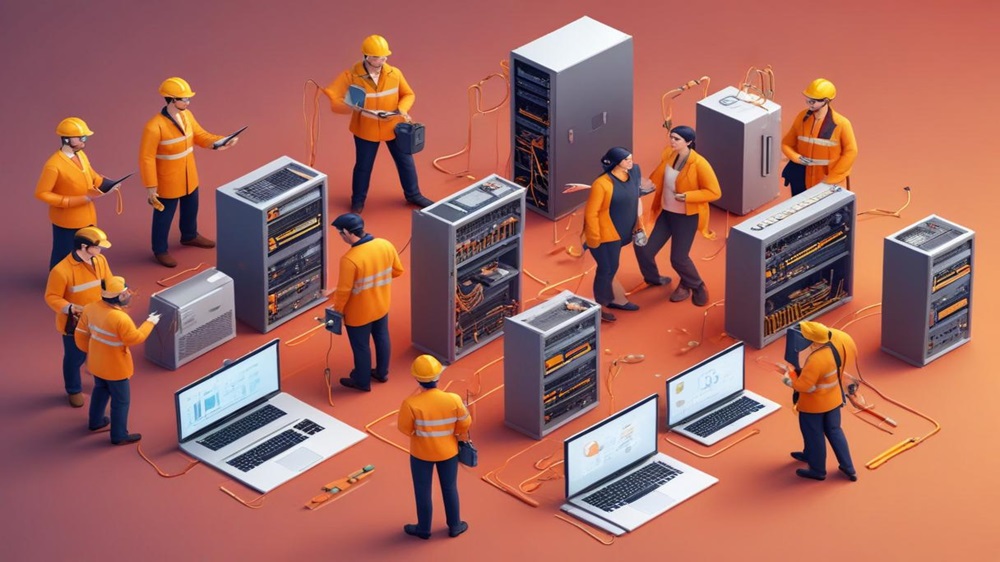Building a Robust IT Infrastructure: Key Components and Best Practices

A robust IT infrastructure is the backbone of any successful modern business. It encompasses various components that work together to ensure smooth operations, support business growth, and maintain continuity. The primary components of a strong IT infrastructure include hardware, software, network resources, and services. This article will discuss these components in detail and provide tips on planning, implementing, and maintaining an efficient and scalable IT environment.
Hardware
Hardware forms the physical foundation of an IT infrastructure. It includes servers, computers, data centers, storage devices, and peripherals. Selecting the right hardware is crucial for ensuring reliability, performance, and scalability. Here are some key considerations:
- Servers: Choose servers that match your business needs in terms of processing power, storage capacity, and redundancy. Virtualization can help optimize server usage by running multiple virtual machines on a single physical server, thereby reducing costs and increasing flexibility.
- Computers and Workstations: Ensure that employee workstations are equipped with the necessary processing power and memory to handle their tasks efficiently. Regularly update hardware to keep up with technological advancements.
- Storage Solutions: Invest in scalable storage solutions such as Network Attached Storage (NAS) or Storage Area Networks (SAN). Consider cloud storage options for additional flexibility and redundancy.
- Backup Systems: Implement robust backup solutions to protect against data loss. Regular backups and offsite storage can safeguard critical business data.
Software
Software is the operational layer of an IT infrastructure, enabling hardware to perform specific tasks. It includes operating systems, applications, and management tools. Key aspects to consider include:
- Operating Systems: Choose stable and secure operating systems for servers and workstations. Keep them updated with the latest patches and security updates.
- Business Applications: Select software applications that align with your business processes. This may include Customer Relationship Management (CRM) systems, Enterprise Resource Planning (ERP) systems, and productivity tools.
- Security Software: Protect your IT environment with comprehensive security solutions, including antivirus programs, firewalls, and intrusion detection systems.
- Virtualization and Containerization: Use virtualization and containerization technologies to optimize resource utilization and simplify management. These technologies enable running multiple applications on a single hardware platform, enhancing efficiency.
Network Resources
A reliable and secure network is vital for communication and data transfer within and outside the organization. Key components include:
- Network Hardware: Invest in high-quality routers, switches, and firewalls to ensure fast and secure data transmission. Redundant network paths can help minimize downtime.
- Internet Connectivity: Ensure a reliable and high-speed internet connection. Consider multiple internet service providers (ISPs) to provide failover options in case of service disruptions.
- Wireless Networks: Deploy robust Wi-Fi solutions to support mobile and remote work. Secure wireless networks with strong encryption and access controls.
- Virtual Private Networks (VPNs): Implement VPNs to provide secure remote access to the organization’s network. This is especially important for supporting remote work and safeguarding sensitive data.
Services
IT services support the infrastructure, ensuring it operates smoothly and efficiently. Key services include:
- IT Support and Helpdesk: Provide employees with access to a responsive IT support team to address technical issues promptly. A helpdesk system can streamline issue tracking and resolution.
- Cloud Services: Leverage cloud services for scalability, flexibility, and cost-effectiveness. Cloud computing can provide Infrastructure as a Service (IaaS), Platform as a Service (PaaS), and Software as a Service (SaaS) solutions.
- Monitoring and Management: Use monitoring tools to keep track of the performance and health of the IT infrastructure. Proactive monitoring can help identify and resolve issues before they impact operations.
- Disaster Recovery and Business Continuity: Develop a comprehensive disaster recovery plan to ensure business continuity in case of unexpected disruptions. Regularly test and update the plan to keep it effective.
Tips for Planning, Implementing, and Maintaining IT Infrastructure
- Assessment and Planning: Start with a thorough assessment of your current IT infrastructure. Identify gaps and areas for improvement. Develop a strategic plan that aligns with your business goals and future growth.
- Scalability: Design the infrastructure with scalability in mind. Choose solutions that can grow with your business without requiring significant overhauls.
- Security: Prioritize security at every level. Implement multi-layered security measures and conduct regular security audits.
- Documentation: Maintain detailed documentation of your IT infrastructure, including hardware and software inventories, network diagrams, and configuration settings. This helps in troubleshooting and future upgrades.
- Training and Support: Ensure that IT staff are well-trained and up-to-date with the latest technologies and best practices. Provide ongoing training and professional development opportunities.
- Vendor Management: Establish strong relationships with reliable vendors and service providers. Regularly review contracts and service levels to ensure they meet your needs.
- Regular Updates and Maintenance: Keep all systems updated with the latest patches and firmware. Schedule regular maintenance to prevent potential issues.
In conclusion, a strong IT infrastructure is essential for supporting business growth and continuity. By carefully selecting and managing hardware, software, network resources, and services, businesses can create a robust, efficient, and scalable IT environment that meets their needs today and in the future.
